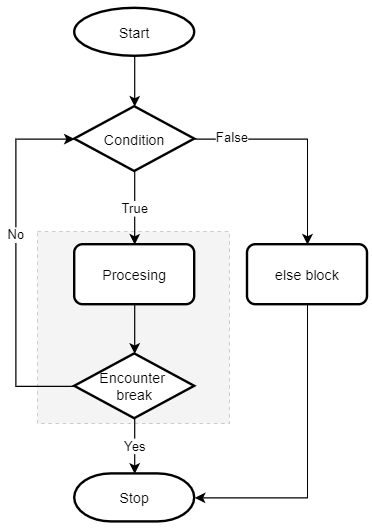Summary: in this tutorial, you’ll learn about the Python while else statement and how to use it effectively.
Introduction to Python while else statement #
In Python, the while statement may have an optional else clause:
while condition:
# code block to run
else:
# else clause code blockCode language: PHP (php)In this syntax, the condition is checked at the beginning of each iteration. The code block inside the while statement will execute as long as the condition is True.
When the condition becomes False and the loop runs normally, the else clause will execute. However, if the loop is terminated prematurely by either a break or return statement, the else clause won’t execute at all.
The following flowchart illustrates the while...else clause:

If you’re familiar with other programming languages such as JavaScript, Java, or C#, you’ll find that the else clause is quite strange in the context of a loop.
However, the while...else clause turns out to be very useful in some cases. Let’s take a look at an example of using the while...else statement.
Python while…else statement example #
Suppose we have the following list of fruits where each fruit is a dictionary that consists of the fruit name and qty keys:
basket = [
{'fruit': 'apple', 'qty': 20},
{'fruit': 'banana', 'qty': 30},
{'fruit': 'orange', 'qty': 10}
]Code language: JavaScript (javascript)We want to make a program that allows the users to enter a fruit name. Based on the input name, we’ll search for it from the basket list and show its quantity if the fruit is on the list.
In case the fruit is not found, we’ll allow users to enter the quantity for that fruit and add it to the list.
The following program is the first attempt:
basket = [
{'fruit': 'apple', 'qty': 20},
{'fruit': 'banana', 'qty': 30},
{'fruit': 'orange', 'qty': 10}
]
fruit = input('Enter a fruit:')
index = 0
found_it = False
while index < len(basket):
item = basket[index]
# check the fruit name
if item['fruit'] == fruit:
found_it = True
print(f"The basket has {item['qty']} {item['fruit']}(s)")
break
index += 1
if not found_it:
qty = int(input(f'Enter the qty for {fruit}:'))
basket.append({'fruit': fruit, 'qty': qty})
print(basket)Code language: PHP (php)Note that there’s better way to develop this program. The program in this example is solely for the demonstration purpose.
How it works:
- First, prompt for an user input by using the
input()function. - Second, initialize the
indexto zero andfound_itflag toFalse. Theindexwill be used for accessing the list by index. And thefound_itflag will be set toTrueif the fruit name will be found. - Third, iterate over the list and check if the fruit name matched with the input name. If yes, set the
found_itflag toTrue, show the fruit’s quantity, and exit the loop by using thebreakstatement. - Finally, check the
found_itflag after the loop and add the new fruit to the list if thefound_itisFalse.
The following runs the program when apple is the input:
Enter a fruit:apple
The basket has 20 apple(s)Code language: CSS (css)And the following runs the program when lemon is the input:
Enter a fruit:lemon
Enter the qty for lemon:15
[{'fruit': 'apple', 'qty': 20}, {'fruit': 'banana', 'qty': 30}, {'fruit': 'orange', 'qty': 10}, {'fruit': 'lemon', 'qty': 15}]
Code language: CSS (css)The program works as expected.
However, it’ll be more concise if you use the while else statement instead.
The following shows the new version of the program that uses the while else statement:
basket = [
{'fruit': 'apple', 'qty': 20},
{'fruit': 'banana', 'qty': 30},
{'fruit': 'orange', 'qty': 10}
]
fruit = input('Enter a fruit:')
index = 0
while index < len(basket):
item = basket[index]
# check the fruit name
if item['fruit'] == fruit:
print(f"The basket has {item['qty']} {item['fruit']}(s)")
found_it = True
break
index += 1
else:
qty = int(input(f'Enter the qty for {fruit}:'))
basket.append({'fruit': fruit, 'qty': qty})
print(basket)
Code language: PHP (php)In this program, the else clause replaces the need of having the found_it flag and the if statement after the loop.
If the fruit is not found, the while loop is terminated normally and the else clause will be executed to add a new fruit to the list.
However, if the fruit is found, the while loop will be encountered the break statement and terminated prematurely. In this case, the else clause won’t be executed.
Summary #
- The
elseclause in thewhile elsestatement will execute when theconditionof thewhileloop isFalseand the loop runs normally without encountering thebreakorreturnstatement. - Try the Python
while elsestatement whenever you need to have a flag in awhileloop.